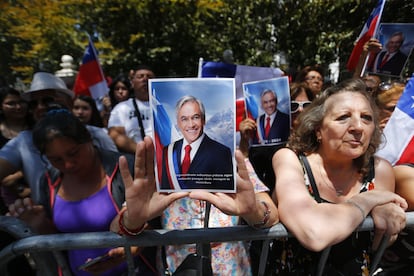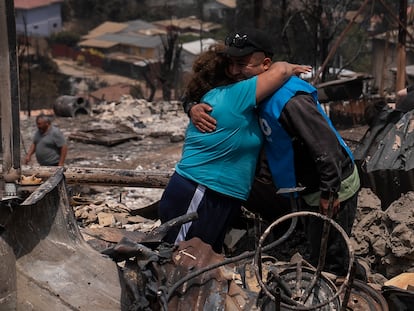‘The helicopter was half-sunk and they couldn’t get him out’: This is how Sebastián Piñera died
The cause of death of the former Chilean president, whose helicopter crashed into Lake Ranco, was asphyxiation due to submersion


It was almost 3:00 p.m. on Tuesday, February 6, when the Robinson R44 helicopter piloted by former Chilean president Sebastián Piñera took off from his friend José Cox’s house, on the shores of Lake Ranco, in the Ilihue sector, southern Chile. Piñera intended to return to his house, located in Coique Bay — on the other side of the lake — to have lunch with his family. Perhaps that is why, although the rain persisted and thick clouds darkened the idyllic summer scene, he chose to ignore the warnings of his friends and boarded the aircraft. By car, the journey from one house to another takes about 50 minutes; by air, approximately 7. However, a quarter mile from the shore, for reasons that are still being investigated, he lost control of the aircraft and plunged into the water. Three of the people who accompanied him (his sister Magdalena, his friend Ignacio Guerrero and his son, Bautista) managed to escape unharmed. Not so the businessman, who went down with the helicopter.
Although there are still no official versions of what happened inside the helicopter, Karla Rubilar, who was a minister in his government, has shared some details of the accident, provided by Magdalena Piñera. A story that reveals how, in his last minutes, the former president chose to save his companions. “You jump first; if I jump with you, the helicopter will fall on you,” he reportedly told the three passengers before falling into the lake and losing his life.
According to another version, told by Fabio Valdés, a friend of the former president since he was five years old, the helicopter fell sideways into the water with its passengers in it, and Piñera did not manage to get out. “The windshield, so to speak, of the helicopter, completely fogged up and he was blinded,” Valdés explained to Radio Agricultura. “One hundred meters [330 feet] away from the Cox house he tried to return to land, to the beach. There, perhaps due to a bad maneuver or some rainfall, I don’t really know very well, but as a result of the circumstances he was experiencing, almost blind, the helicopter fell and fell on its side, towards his side. And he must have received the blow. There, Ignacio Guerrero, who was in the side of the helicopter farthest from the water, opened the doors. He came out, his son came out, and Sebastián’s sister Pichita [Magdalena] barely got out. They tried to get Sebastián out, but the helicopter was already half-sunk and they couldn’t get him out.”
His body was successfully recovered by Lake Ranco firefighters that same day after 4:00 p.m. and taken by boat to the Harbor Master’s Office. Ricardo González, the Fire Department diver who participated in the immersion, told the Public Prosecutor’s Office and relatives of the former president that they were able to find the body, which was floating outside the aircraft, in a matter of minutes. “The extraction was not complicated, as the weather conditions, temperature, water, wind, depth and exploration were favorable for free diving,” González explained, according to the La Tercera newspaper.
Piñera’s body floated without a seat belt or anything that would keep him submerged. “He was free, without his belt, next to the helicopter, 28 meters [92 feet] deep,” he said.
The assessment carried out by the Legal Medical Service, after a four-hour autopsy performed on Tuesday night, confirmed the cause of his death: asphyxiation due to submersion. The information was first delivered to the former president’s family and later confirmed by the Los Ríos prosecutor. “As the Prosecutor’s Office we are already in a position to inform the community that the medical-legal cause of former president Sebastián Piñera’s death is asphyxiation due to submersion,” stated Prosecutor Tatiana Esquivel.
The versions that during Tuesday afternoon suggested that the former president had suffered a heart attack were ruled out. “The forensic or medical-legal examinations allow us to develop a more likely theory of what the dynamics of this plane crash would have been like. As we pointed out, at this moment there is also a technical team dedicated to conducting all the assessments related to the helicopter where the accident took place,” stated the prosecutor.
With the cause of death clarified, it is now time for inquiries to determine the cause of the helicopter failure. For this, the regional prosecutor has ordered the opening of an investigation to clarify the circumstances surrounding the incident. “What follows are the assessments related to the helicopter that crashed in Lake Ranco in order to establish the cause and origin of the accident, obtain additional information and understand the sequence of events,” she said.
The investigations involve the Homicide Brigade and the Criminalistics Laboratory of the Investigations Police, as well as the Special Police Operations Group of the Carabineros. “The accounts [of the surviving passengers] are analyzed with technical assessments, aiding in the reconstruction of the cause and origin of this accident,” Esquivel explained.

A conversation with Boric
Piñera was vacationing at his Coique Bay home with his wife, Cecilia Morel, his sister Magdalena Piñera and some of his grandchildren. Every summer, the former president used to visit friends who spend the summer in nearby areas, either by boat, car or helicopter, depending on the distance. Days before the fatal accident, he had traveled by helicopter with his friend Ignacio Guerrero, who also accompanied him on the aircraft minutes before his death, and his former minister Rodrigo Pérez Mackenna, to Tantauco Park, a private conservation reserve that Piñera owned since in 2006 on the island of Chiloé, in the Los Lagos region. During this journey, they also flew over the Futaleufú area on the continental Chiloé. Additionally, on Monday, he visited Camping Futrono by boat to meet with another group of friends, according to La Tercera.
Those who spoke with him during those days say that he was very concerned about the consequences of the massive fire that occurred over the weekend in the Valparaíso region. For this reason, he was working in utmost secrecy with a group of former collaborators and ministers on a document explaining how to proceed, to share it with the current government. Piñera and his teams had experience in this regard after dealing with the reconstruction process following the 2010 earthquake, during his first term, as well as the Covid-19 pandemic emergency during his second term. On Monday morning he held a video conference with part of his team to coordinate the delivery of a document to Gabriel Boric’s administration, to support the reconstruction efforts following the tragedy that occurred over the weekend, which has already claimed 131 lives.
Sources close to Piñera confirm that he reached out to President Boric to offer his expertise on Monday. That conversation led to another: that night, the former president received a call from Javiera Toro, the current minister of social development, who is in charge of the reconstruction efforts following the fires in the Valparaíso region. They spoke for about half an hour, during which Piñera shared his experience and offered his assistance.
Karla Rubilar, a former minister that was part of the team of collaborators working on the document, confirmed the existence of a draft that was going to be handed over to the current administration. “The president [Piñera] was asking us to help this government, legitimately, very discreetly. He said, ‘Don’t talk about it, keep it low-key, let’s help the president with the reconstruction, let’s make ourselves available.’ He asked us to call the ministers, to write them. Why am I telling this? Because that was [how he was],” she said.
Sign up for our weekly newsletter to get more English-language news coverage from EL PAÍS USA Edition
Tu suscripción se está usando en otro dispositivo
¿Quieres añadir otro usuario a tu suscripción?
Si continúas leyendo en este dispositivo, no se podrá leer en el otro.
FlechaTu suscripción se está usando en otro dispositivo y solo puedes acceder a EL PAÍS desde un dispositivo a la vez.
Si quieres compartir tu cuenta, cambia tu suscripción a la modalidad Premium, así podrás añadir otro usuario. Cada uno accederá con su propia cuenta de email, lo que os permitirá personalizar vuestra experiencia en EL PAÍS.
¿Tienes una suscripción de empresa? Accede aquí para contratar más cuentas.
En el caso de no saber quién está usando tu cuenta, te recomendamos cambiar tu contraseña aquí.
Si decides continuar compartiendo tu cuenta, este mensaje se mostrará en tu dispositivo y en el de la otra persona que está usando tu cuenta de forma indefinida, afectando a tu experiencia de lectura. Puedes consultar aquí los términos y condiciones de la suscripción digital.
More information
Archived In
Últimas noticias
Most viewed
- Oona Chaplin: ‘I told James Cameron that I was living in a treehouse and starting a permaculture project with a friend’
- Reinhard Genzel, Nobel laureate in physics: ‘One-minute videos will never give you the truth’
- Sinaloa Cartel war is taking its toll on Los Chapitos
- Why the price of coffee has skyrocketed: from Brazilian plantations to specialty coffee houses
- Silver prices are going crazy: This is what’s fueling the rally









































